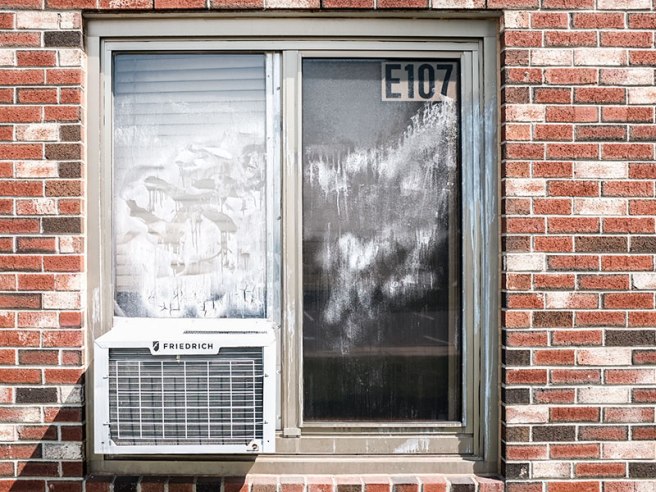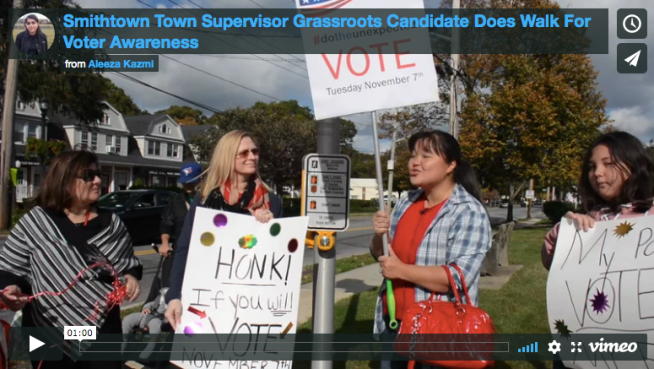Gov. Cuomo proposes sex education overhaul in response to #MeToo movement
By Aleeza Kazmi and Joseph Konig
In response to the growing #MeToo movement, New York State Gov. Andrew M. Cuomo proposed a K-12 curriculum overhaul to address consent and healthy relationships last month, a policy supported by many women’s rights activists on Long Island.
The plan, announced on Jan. 11, is part of Gov. Cuomo’s 2018 Women’s Agenda for New York. The program, titled “Be Aware-Be Informed,” is part of the governor’s proposal for the state budget in fiscal year 2019, which begins on April 1, 2018. The governor requests that the proposed curriculum have the same definition of consent established by the “Enough is Enough” law, passed in 2015 to address sexual assault on New York college campuses. If included in the budget, the governor’s office plans to have the program ready for the start of the school year in September, deputy press secretary Hazel Crampton-Hays said.
“Other topics shall include age-appropriate information on confronting and avoiding sexual harassment and assault and teen dating violence, as well as medically accurate sexual health,” a Jan 22. press release said.
The call for this progressive education initiative echoes the sentiment of activists on Long Island who believe consent needs to be taught beginning with children as young as 3 years old.
“We have to start talking about consent and boundaries and respect in pre-K,” #MeToo Founder Tarana Burke said during a Jan. 28 forum in the Student Activities Center Sidney Gelber Auditorium. “Kids are not dumb, they are sponges. They will accept and understand those concepts, and then you have to layer on those lessons every year until they get out of high school in order for us to really have a shift in our culture.”
The current state regulation that mandates health education does not mention consent, sexual violence or even sex. The decision to include sex education curriculum is left to individual school districts. AIDS prevention is the only aspect of sex education mandated by the state, with the caveat that abstinence must be highlighted as the “most appropriate and effective” prevention method. Additional instruction must be “age appropriate and consistent with community values.”
“Every other subject has standardized education and standardized testing,” Elizabeth Osowiecki, an education coordinator for The Safe Center LI, said. “[Sex education] is the only thing that is not standardized.”
The Safe Center LI is a non-profit based in Bethpage that serves the victims of family violence and sexual assault. Osowiecki and her colleagues spend hours each week in Nassau County schools teaching students about consent and healthy relationships through the “Safe Dates” program.
“It’s so important to talk to teens and young adults about healthy relationships and consent because these are conversations they’re probably not having with their friends,” Osowiecki said. “We are trying to push to have consent-ed and healthy relationships education.”
Effective education about the prevention of dating violence has been shown to lower incidences by 60 percent, according to a 2018 report published by the New York State Council on Women and Girls. In Cuomo’s proposal, the new curriculum would be made available to schools, but not required.
“[Schools in Nassau County] weren’t giving a detailed enough explanation of consent,” Osowiecki said. “I don’t think they were spending enough time on the topic. If you aren’t having these conversations, it’s hard to care.”
Cindy Morris, whose consulting firm helped put together the #MeToo forum Burke spoke at, takes issue with the current sex education system.
“We don’t start teaching sex-ed, at least in my children’s district, until sixth grade and that is too late,” Morris, who has children in the third and seventh grades in the Three Villages Central School District, said. “[We need to] talk, not necessarily graphically about these things, but about protecting your body. You have the right to say no to anybody who wants to touch your body for any reason. Even if it is just to ‘hold your hand.’”
Some Long Island schools are beginning to discuss integrating topics of sexual violence into their sex education curriculum.
“As Director of Health, I did start the conversation [about #MeToo] with teachers at the beginning of this year,” Stephanie Joannon, the director of health, physical education and athletics at Paul D. Schreiber High School, said. “In 11th grade, this is a dialog we are having, and we talk about it differently than we did 5 years ago, so the #MeToo movement would be a part of that.”
Between fall 2011 and spring 2015, there were an estimated 17,000 reported cases of K-12 student-on-student sexual violence nationwide, according to a 2017 analysis by the Associated Press. The Associated Press clarified in the analysis that their estimate “does not fully capture the problem because such attacks are greatly under-reported, some states don’t track them and those that do vary widely in how they classify and catalog sexual violence.”
“Sexual assault is not something reserved for adults or reserved for high schoolers or college students,” Morris said. “It is something that is happening to our young people. It is something that is happening to children. And when we deny them the chance to protect themselves, we are complicit in the problem.”
Smithtown Candidate for Town Supervisor Is One of At Least Six Grassroots Candidates on Long Island
By Aleeza Kazmi and Meng Yuan
When Kristen Slevin opened a candy boutique with her husband in Smithtown last February, she had no idea a little more than a year later she would be running for Town Supervisor, the highest governmental position in the town.
Customers of her shop became volunteers for her campaign and helped Slevin get the 1,500 signatures from Smithtown voters that are required under state law for an independent candidate to run in a general election.
As an independent, Slevin is one of at least six grassroots candidates on Long Island running for office in the upcoming election on November 7th. These candidates are community members with little to no political experience who are dependent on small donations to fund their campaigns.
But Slevin is not even accepting any donations to her campaign, instead limiting herself to a personal budget of $1,000.
“No fundraising opens us up to having people get involved,” Slevin said. “Money is always the easiest way to get things done. You always go to money as the first resource, but when you eliminate it, then you are forced to think outside the box.”
As a side business, Slevin worked as a social media consultant for 5 years and has used social media as her primary campaign medium. By spending $10 to boost a Facebook post from her campaign page, Slevin was able to reach up to 2000 people per post, compared to the roughly 980 that follow her page.
The Facebook boosts have cost Slevin $400, and her knowledge of how to navigate social media has saved her the $14,480 the Republican candidate for town supervisor, Ed Wehrheim, has spent on consulting during his campaign.
The other two candidates for Smithtown Town Supervisor have extensive government experience. Wehrheim has served as a Smithtown councilman for 14 years and the Democratic candidate, Bill Holst, has been elected twice to the Suffolk County Legislature.
Smithtown Republicans have said Slevin’s lack of government experience will be a hindrance to her ability to perform as Town Supervisor.
“Someone can’t come in off the street totally unprepared to try to take over as the supervisor, which is the leader of the government,” Bill Ellis, Smithtown Republican Committee chairman, said. “There’s nothing like experience, especially in government and politics.”
But Slevin’s supporters argue her inexperience in government could be a strength.
“I do like the fact that Kristen is not a politician, I like the fact that she’s a small business owner and because she became a small business owner she realized there was a need in Smithtown for kind of grassroots change, because nothing was changing,” Janet Philbin, a volunteer for Slevin and a 40-year resident of Smithtown, said.
Grassroots organizations have emerged on Long Island in the past year as a result of the anti-Trump resistance and the progressive grassroots mobilization that grew out of the Bernie Sanders campaign, Ron Widelec, a member of grassroots organization Long Island Activists, said.
“Often times it does take some kind of catalytic event but the grassroots organizers lay the groundwork, the tinder, so that when that event happens, they have their lists, they have their community organizers, and they can then use the event as the [instance] that finally wakes people up” Lawrence Levy, executive dean of suburban studies at Hofstra University and former Newsday political columnist, said.
Grassroots is not a synonym for progressive, as the Tea Party movement started as a grassroots effort following the inauguration of President Obama in 2009. They can also be bipartisan, Liuba Grechen Shirley, founder of the Long Island grassroots organization New York Second District Democrats, said.
“With electing Donald Trump and then the aftermath of people being really upset on both sides of the aisle, I think that there was a growing movement of people who felt their voices weren’t being heard,” Grechen Shirley, who founded New York Second District Democrats two months after the 2016 presidential election, said.
Now, Grechen Shirley is one of the Long Island grassroots candidates running for office. She launched her campaign last week for the 2018 congressional election as a candidate for New York’s 2nd district.
As a grassroots candidate, Grechen Shirley said the biggest criticism she hears is that it will be difficult for her to raise the approximately $5 million it will take to run against the two-term incumbent, Peter King. But in the first week of her campaign, she surpassed her donation goals.
“I set out a goal of to have 100 grassroots donors in the first week, we had more than 200 and we are well on our way to having more than 300 donors in the next couple of days, which is incredible,” Grechen Shirley said.
Grassroots candidate for Suffolk County Legislature, Joe Tronolone, said 90 percent of his donations are $50 or less.
“Making a transition from a grassroots activist to a candidate without full resources of the established centers of power and influence is tough, but it’s important that we get out there and do it,” Tronolone, who is a math teacher in Islip, said. “Grassroots politics in general are really the driving force because the things we advocate for really from the grassroots really make it into the mainstream, which makes it into legislation.”
In addition to being a small-business owner, Slevin served as vice president for the Swan Lake Civic Association, which was actively involved in the recent revitalization of downtown Patchogue.
“I think sometimes, not just here locally in Smithtown but anywhere, you need fresh ideas,” Slevin said. “You need somebody who’s going to get out of the trees and look at the whole forest.
Huntington Public Art Initiative Faces Defunding as Art is Jeopardized Across the Island
By Sophia Ricco and Aleeza Kazmi
Police sirens wail as a stream of cars flow down Main Street in Huntington, passing by the painting of a sailboat floating peacefully into a purple sunset. Created by William Low, the scene uses one of the Town’s traffic signal boxes as a canvas. The Traffic Signal Box Project is one of Huntington Public Art Initiative’s ventures, but the 10 other boxes scheduled to be painted this year may never be completed if the Town Board doesn’t renew the Initiative’s budget for 2018.
The town has 13 ongoing public art projects in the plan, but the Initiative has exhausted the $15,000 the town allocated to them in 2011 that has kept them afloat, in addition to outside funding, until now.
“Public art is one of those important creative tools in any municipality’s quiver to make a community a more desirable place to live and work, and it fits in with other kinds of quality of life initiatives,”John Coraor, Huntington director of cultural affairs, said. “People don’t like to live and work in a community that doesn’t have vital and thriving arts and culture, and public art is one component of that.
The Town Board has until Nov. 20th to approve the town budget, and at least three of the five board members need to vote in favor of allocating money to the Initiative in order for them to receive funding. There is no funding in the budget right now for the Public Art Initiative, but funding can come back if the initiative has specific requests, AJ Carter, the Town’s spokesperson, said.
Local arts programs face financial challenges at the federal level as well. The 2018 budget proposed by President Trump eliminated the National Endowment for the Arts, a federal agency that provides funding for art programs throughout the country. The NEA funding for the 2017 fiscal year was about $148 million, which is 0.02 percent of the federal budget and is not even enough money to build a mile of freeway expansion.
“The federal government making the decisions that is has made to withdraw funds and place them more towards the sciences and Math, it is a real shame, it is a tragedy for the Long Island arts,” Kevin McEvoy, director of The Atelier at Flowerfield, a Saint James based not-for-profit art studio, said.
Local art organizations that rely on government funding are becoming more reliant on private funding. The Huntington Arts Council, a not-for-profit that provides art programs and services to local artists, will hold an auction on December 1st with donated art pieces to raise funds.
“We as a community can’t just sit back and rely on what we hope is going to be grants and funding from the government,” Chris Ann Ambery, an artist from Smithtown who donated a piece to the auction, said. “We have to continually get out there, be active, do events like this.”
The Huntington Arts Council currently receives a $300,000 grant from New York State that makes up one-third of its budget. About $250,000 of the grant is distributed among arts organizations, leaving the Council with only $50,000 of their government funding for operating costs.
“Everything costs money and we do not want to not pay someone,” Kieran Johnson, business manager of the Council said. “Artists deserve pay just like everyone else.”
The primary goal of the Huntington Public Art Initiative is to create a better visual environment in the town, but public art also helps build the local economy.
“It makes the experience of people visiting a little bit more enjoyable, which makes them want to shop and visit restaurants,” Coraor said. “It’s part of the atmosphere that makes people want to live in those kinds of area and that helps to drive an economy, and that helps to build a community.”
For some Huntington residents, the public art is really just about making the town more beautiful.
“I think Huntington needs public art, it is desperate for it,” Devon Fox, a Huntington resident, said. “There are so many places that are just dying to be painted. We need art.”
Long Island High School Football Playoffs Kick-Off With Lowest Participation in Half a Decade
By Briana Panetta and Aleeza Kazmi
Joe Crima has broken his hand, fractured his back, sprained both his ankles multiple times and suffered a concussion this past season all while playing football. None of these injuries stood in the way of the Kings Park High School football senior from pursuing what he loves to do. But that’s not the case for all high school football players on Long Island.
Since the 2009-2010 school year, there are 2,347 fewer boys playing high school football on Long Island, nearly a 15% decrease, according to the New York State Public High School Athletic Association.
“I think it’s because parents are scared of their kids getting hurt,” Joe Betz, a sophomore football player at St. Anthony’s High School said. “It doesn’t really surprise me, there’s a risk of getting hurt for no reason because not too many people from Long Island go to professional football or even a division one college.”
Football claimed the life of a Sachem East High School student in August. Joshua Mileto died when he was hit in the head by a 400-pound log being used during a military-style summer conditioning drill.
“Everyone’s always talking about the concussions, the dangers of playing football, the head injuries and things like that, but nobody ever asked ‘what are you doing to address this situation?’” Patrick Pizzarelli, Executive Director of the Nassau County Section of The New York State Public High School Athletic Association (NYSPHSAA), asked. “But we are addressing that. We are trying to make football a safer game so kids won’t be putting themselves at injury.”
The Nassau County high school football playoff semifinals start this Thursday at Hofstra University. At every game there will be a certified athletic trainer in the booth with binoculars watching the game looking for any child with a potential head injury, Pizzarelli said. Players suspected of being injured will get pulled out for an assessment.
As of last year, every high school and middle school coach in Nassau County is required by Section XIII to have Heads Up Football, a program developed by USA Football to increase players’ safety by teaching tackling and blocking techniques, concussion recognition, coaching education and more. Nassau and Suffolk County coaches are also required by the NYSPHSAA to follow the Tommy Tough Football Standards, a program created to increase awareness of head injuries following the death of Tommy Cutinella during a 2014 high school football game in Elwood.
“If football players do have a problem or injury or pain they should not hold that to themselves,” John Higgins sports cardiologist with McGovern Medical School at The University of Texas Health Science Center at Houston said. “Sometimes the really stellar coaches might tell them no pain no game, you got to be a man. If someone is injured and they do continue to play on it could get a lot worse.”
A study published in July found chronic traumatic encephalopathy, or CTE, in the brains of 21 percent of high school football players that were studied. CTE is caused by head trauma and leads to dementia, memory loss, and suicidal thoughts among other symptoms.
“You never know when an injury can or will occur so it’s hard to prevent them,” Crima said.
Halloween Attraction Raises Funds for Center Moriches Special Needs Camp
By Aleeza Kazmi and Beth Smith
Red and white strobe lights flash on Lauren Bianco’s blood stained face as she sits in an electric chair with a knife through her head, screaming at anyone who passes her. But Lauren is fine. The blood and knife are just an illusion and in between scaring passersby, she giggles to herself in sheer delight.
Lauren is a volunteer at the annual Spooky Walk at Camp Pa-Qua-Tuck in Center Moriches that runs the last two weekends in October. All the funds raised at the event go to the special needs camp, where she spends parts of her summer.
“I love everything about camp and I love every bit of volunteering,“ Lauren, 32, who is mildly developmentally disabled, said.
The walk is organized by The Moriches Paquatuck Squaws, a non-profit organization that’s sole purpose is to fundraise for Camp Pa-Qua-Tuck. The event raises up to $150,000 each year for Camp Pa-Qua-Tuck and hasraised over $2 million dollars since it started in 1989, Marcella Weiss, the Spooky Walk Coordinator, said. The money raised helps ease the burden of parents sending their children to the camp.
“If it wasn’t subsidized by the fundraising efforts, then I don’t think I would be able to send my daughter there,” Barbara Saltare, whose daughter has attended Camp Pa-Qua-Tuck for 7 years, said. ”We do have to pay, but we don’t pay nearly as much as it costs to run the program, because of the efforts of the fundraising.”

Special needs camps of a similar size operate under a $1.2 million yearly budget, like The Southampton Fresh Air Home, the camp director David Billingham said.
The entrance fee to the Spooky Walk is $20, and on Saturday, some waited in line for an hour and a half to go through the 45-minute attraction. Attendees start the walk in the woods, where dressed-up volunteers pop out to scare them, then they go through 4 different cabins, each with their own spooky theme. This year the cabin themes include a psych ward, scary circus, Alice in “Zombieland”, and a monster-mash dance party.
“The Spooky Walk I feel is the best of its kind on Long Island,” Lisamarie Rykowski, who has attended the attraction at least a dozen times, said. “They do such a great job decorating and then staying in character that me and my adult friends go every year.”
Preparations for the event begins at the end of August and it takes nearly 500 unpaid volunteers to run the four-night event, Christina Tagliavia, a Moriches Paquatuck Squaws member, said.
“In the beginning years, I begged and got anyone I could get to volunteer in this,” Weiss, who started the Spooky Walk the year after she joined the Squaws, said. “I remember my kids were playing soccer and I would be running around the soccer field trying to get parents to volunteer.”
After 29-years of Spooky Walks, Weiss said she doesn’t have to go looking for volunteers. They contact her.
The Spooky Walk is the largest fundraiser of the camp, which receives no federal or state funds, Tagliavia said. Camp enrollment is $975 per week, but each camper actually costs the camp roughly $2,500 per week.
“No child gets turned away based on finances. If they can’t afford it, we will find a way for them,” Janice Graf, President of the Moriches Rotary Club, which owns the camp, said.
Roughly 11 percent of the people living in Long Island under the age of 65 have a disability, according to the US Census Bureau which is slightly higher than the national average of about 9 percent.
Lauren has been a camper since 2016 and hopes to return to Camp Pa-Qua-Tuck next summer.
“It’s so important for kids with disabilities and adults, like me, to have the opportunity to go to camp in the summer,” Lauren said, as the white paint covering her face cracked in her smiles lines
At Least Two Rallies Held During Jewish High Holidays to “Wake Up” Rep. Lee Zeldin
By Aleeza Kazmi, Sophia Ricco, Briana Panetta, and Meng Yuan
At least two protests were held within one week outside of Rep. Lee Zeldin’s Patchogue office, one over the issue of gun control and the other about what protesters called the congressman’s complicity with President Trump’s agenda.
Zeldin, a Republican who received nearly $9,000 from the National Rifle Association during the 2016 election cycle, came under scrutiny by progressive groups after supporting Trump’s statement that “both sides” were to blame for the violence at the neo-Nazi rally in Charlottesville.
On Thursday October 5, around 40 protesters gathered outside of the congressman’s main district office to protest for and against gun control.
Those in support of gun control were there to demand more strict rules on gun regulation and raised awareness of gun violence. Another group of protesters were there to defend the 2nd Amendment rights and believed more gun control laws cannot stop criminals, James Saccardi, a protester who strongly opposed strict gun control, said.
“I am a defender of 2nd Amendment Rights,” Saccardi, the founder of the ‘Lee Zeldin Defenders’ group on Facebook, said. “More strict laws on gun control will do nothing to keep guns out of the hands of criminals. Criminals do not follow the law, that is why they are criminals.”
Protesters in support of gun control started the protest with the Bob Dylan song, ‘Blowin’ in the Wind’, Jeff Keister, a leading gun control advocate at the demonstration, said.
“Gun rights advocates may not understand that the laws as they exist now make it easy for guns to fall into dangerous hands,” Keister said.
The officials of the Village of Patchogue took little notice of the gun control protest.
“I was not at the protest, and I have no knowledge about it.” John A. Krieger, the Deputy Mayor of the Village of Patchogue, said.
Zeldin has accepted nearly $15,000 from the National Rifle Association since his first congressional run, according to the Federal Election Commission.
“Protesting plays a role in affecting change but can’t do it on its own,” Luis Montes, Managing Partner of GSL Consulting Group, communications and political consulting firm, said.
Four days after the gun rights protest, on Monday October 9, a little more than three dozen people gathered in the rain outside of Zeldin’s Patchogue office to protest what they call the congressman’s “complicity” with President Trump’s agenda.
Jewish action group Bend the Arc came together with Long Island based progressive groups to organize the protest. Jewish people account for 4.6% of Zeldin’s congressional district, according to the 2010 census.
Zeldin is one of only two Jewish Republican representatives, out of 30 in total.
Zeldin has voted lockstep with President Trump since his election and supported the president’s statement that “both sides” were to blame for the violence that erupted after neo-Nazis and white supremacists marched in Charlottesville in August. His support sparked a petition demanding he be removed from the U.S. Holocaust Memorial Council.
“We are gathering here today at this time in the Jewish Calendar during the high holiday season because the high holidays are a time of awakening, accountability and atonement,” Kayla Glick, Bend the Arch Community Organizer, said in the protest’s opening statement. “And this year, Rep. Zeldin has so much to atone for.”
The Long Islander reached out to Zeldin’s office and they declined to comment on the protest.
Progressive groups have protested outside of Zeldin’s main district office in the past, but have never received a response from the congressman.
“I get these ridiculous letters from him when I send him something either by email, or telephone or fax,” Phyllis Hartmann, Long Island resident and Bend the Arc member, said. “He sends me some very unthoughtful general response back. He’s never actually responded to anything, he’s afraid of all of us, or doesn’t care about all of us.”
The protest organizers compiled a list of demands that included Zeldin censure President
Trump, call for the firing of Stephen Miller, vote to remove all Confederate symbols from the Capitol, and pass a DREAM Act with no attached funding for a border wall or immigration enforcement.
Last month, Trump announced the end of the Deferred Action for Childhood Arrivals (DACA), which protects minors brought into the country illegally as children, who are also known as “dreamers.”
After Trump announced the end of the Obama-era program, Rep. Zeldin put out a statement on his website.
“It is great to pursue the American dream and to consider yourself a ‘dreamer’ and everyone in the United States legally should consider themselves ‘dreamers’, but you have to follow our laws. Period. We should not reward or excuse criminal behavior,” Zeldin said in the statement.
“These programs help protect for many families,” Rodman Serrano, a community organizer for the progressive group Make the Road New York, said. “It’s the only protection they have and it’s really unjust that we have a congressman who is not being responsive and he’s not being responsible to his constituents.”
Serrano’s parents are immigrants from El Salvador and are living in America under Temporary Protected Status (TPS). The renewal of TPS designations are at risk under Trump’s immigration laws.
Protesters also expressed their concern over Zeldin’s response to recent alt-right demonstrations. The night before the Bend the Arc protest, Nazis gathered again in Charlottesville, N.C., this time outside the local synagogue as they observed the Jewish holiday Sukkot. Zeldin has not made any public comments about this recent Nazi demonstration.
“As a constituent of Congressman Zeldin, I was quite disappointed in his response to the violence in Charlottesville, his silence on the appearance of KKK flyers in Patchogue and Amagansett this past year, his demonization of immigrants, and his support of the proposal of the wall in Mexico and Trump’s travel ban,” Shoshana Hershkowitz, founder of Suffolk
Progressives, another group in attendance, said.
At the protest, Rabbis from Long Island called on Zeldin to make moral judgments in congress.
“Our Torah commands, ‘See I have placed before you today, life and good, death and evil, choose life,’” Jan Uhrbach, a rabbi at the Conservative Synagogue of the Hamptons, said in her speech at the protest. “There are moments in life where the choices before us are especially stark, and the stakes in our choosing especially high.”
New State Grant Program Will Help Military Veteran Farmers
By Aleeza Kazmi and Tiffani Golding
New York State approved a grant program last week that could provide farmers who are military veterans with up to $50,000 to increase their farm production.
The Veterans Farmer Grant Fund was approved by New York State’s primary economic development agency, Empire State Development. The FY 2016-2017 New York State budget appropriated $250,000 for the program, according to the grant guidelines. Any further funding will need to be allocated in future state budgets, ESD Press Secretary Adam Ostrowski said in an email. Veterans who are selected to receive the grant will obtain between $15,000 and $50,000.
Long Island agriculture is a one billion dollar-a-year industry and it brings in additional revenue for the Island’s other industries, such as tourism, travel and hospitality, according to the Long Island Farm Bureau.
“A dollar put into a local farm gives back much more to that local community than if I spent my dollar for gasoline or at Wal-Mart, or something like that,” Dean Koyanagi, Veterans Program Associate at Cornell’s Small Farm Program, said.
Local economies are not adversely affected by grants given to veteran farmers, John Lemondes, Board President of the Farmer Veteran Coalition New York State Subchapter, said. Lemondes is a decorated veteran army Col. and farmer in Lafayette, New York.
There are 405 veteran farmers who are members of the Farmer Veteran Coalition, said FVC fellowship manager Rachel Petitt.
“The names we know are just a fraction of what is out there,” Lemondes said.
The evaluation process of applicants for the Veterans Farmer Grant Fund will be competitive. The grant guidelines include an extensive list of eligibility criteria. One of the qualifications is that farmers must have day-to-day participation with their farm. Some veterans, however, are unable to participate in their farm on a daily basis.
“I would like this to be my full-time profession, and a lot of other people have the same feeling, but it’s hard to do, it’s going to take a while before you can build up enough business so you can actually quit your day job,” Michael Mission, who is an army veteran and owns an oyster farm in the Great South Bay off the coast of Bay Shore. “You can’t quit your day job with the hopes of a harvest three years down the road.”
On weekends, Mission tends to the Blue Point oysters on his farm, and during the week he works as a construction insurance rater.
The Veterans Farmer Grant Fund is modeled after the New Farmers Grant Fund, the grant description shows. Governor Cuomo announced the $1 million New Farmers Grant last October.
“New York’s farmers are a rich part of this state’s heritage and remain essential to the success of our economy,” Governor Cuomo said in a statement announcing the New Farmers Grant in 2016.
There is a shortage of farmers in New York State, Koyanagi, who is a farmer in Ithaca and Marine Corps veteran, said.
“Veterans seem like a good opportunity, because all these people who work real hard, like being outdoors, aren’t afraid of long hours and hard work, and farming needs people like that,” Koyanagi said.
Veterans have until Jan. 26 to apply for the program, and grant recipients will be announced in late spring/early summer 2018.
Long Island Throws Hat in the Ring to Become Site of Amazon’s Second Headquarters
Long Island officials met with New York State and city officials in Manhattan last Tuesday to discuss a coordinated pitch to bring Amazon’s second headquarters to New York.
Empire State Development, New York State’s economic development agency, is coordinating efforts to bring the tech giant’s second headquarters to the state, and Long Island’s chamber of commerce, Long Island Association, wants to bring it to the Island.
“I don’t think it’s going to make a difference whether it’s in New Jersey or Long Island, I don’t think it’s going to do much for the smaller companies, Amazon is already nationwide,” Robert Wahlen, CEO of Techs in a Sec, a computer support company said.
Amazon released a Request for Proposal (“RFP”) earlier this month with an extensive list of criteria for what they are calling “HQ2”. The requirements for their $5 billion dollar investment include a business-friendly and stable environment, an area containing more than a million people, and an urban or suburban location with potential to house their workforce. The Long Islander reached out to Amazon for a comment but they failed to respond.
“Long Island checks all the boxes of the RFP requirements,” Matthew Cohen, Long Island Association Vice President of Government Affairs & Communications, said.
Amazon will begin to search for talent once the final decision of the location is made, according to the RFP. The RFP also states that the technology company projects to hire around 50,000 full-time employees with an average salary exceeding $100,000.
“Long Island already has a very strong technology center and Amazon is one of the global leaders in technology,” Paul Trapani, Vice President of LISTnet, said. “In addition to all the great companies we have here for technology, we also have some of the top universities like Stony Brook, Hofstra, and NYIT, that are sources of technology talent.”
Current revitalization of 40 downtowns across the island make it a prime location for an Amazon workforce, Eric Alexander, director of Vision Long Island, a not-for-profit focused on downtown development and infrastructure investment on Long Island, said.
“Not everyone is going to live right at Amazon’s campus,” Alexander said. “To have downtown housing opportunities and experience that are nearby, you know Long Island needs to be an exciting place for that type of workforce.”
But Long Island is just one of many places attempting to woo Amazon. “Many different regions throughout New York State are also interested in bringing Amazon to them but the state will ultimately have to pick one horse and run with it.” Cohen said. Specific sites for the proposed headquarters are being discussed in both Suffolk and Nassau County, Cohen added.
Some in the technology industry think it may be detrimental to competitors on the island.
“This will have the same effect as Walmart, BJ’s, and Costco did. They will knock the smaller competition off the island,” Tony O’Hara, a New York City Department of Education engineer, said. “The three I mentioned are feeling the effects of Amazon already and have been trying to gain Internet sales which Amazon is basically eating up like wildfire.”
Long Island officials have until October 19 to submit their proposal but residents of the island will have to wait until 2018 to find out if Amazon picks it for the location of their second headquarters.
Syosset School Board Faces Tough Security Questions at Upcoming Board Meeting
By Tristan Manaloto and Aleeza Kazmi
A member of Syosset’s Central School District Board said he will request an increase in security at the next board meeting, following the anti-Semitic and gang-related graffiti found at Syosset High School last week.
“I will make a public call to beef up security around all 10 buildings, so that an action of hate becomes an exception, as opposed to a precedent,” Joshua Lafazan, Syosset School Board of Education Trustee, wrote in a Facebook statement.
A school security guard found white spray paint on doors, walls, and windows in the back of the school the morning of August 27, according to a police report. Two Long Island reporters visited the school and noted there are no visible security cameras where the sprayed-on swastikas and MS13 symbols were found.
Hundreds of parents have called Lafazan questioning the capabilities of the security companies the district currently employs.
“I like the fact that Josh is stepping up to make the building and the school district more secure,” said Theresa Walch, who has been a parent in the district for over 20 years. “It would be good looking out for the children and the parents. Children for their safety, parents for their peace of mind.”
There are security guards seven days a week at the high school during certain hours, Robert Calabrese, the Long Island Regional Manager for Summit Security said. Summit Security is one of two security companies at Syosset High School.
“They’re there to patrol, make sure no one is breaking in, things like that,” Calabrese said.
After talking to Calabrese, two Long Islander reporters were able to walk into Syosset High School without being stopped by security last Sunday, the same day of the week when the vandalism occurred. One wing of the school was open during a cheer practice and there were no apparent security guards.
The Long Islander reached out to the public relations firm for Syosset Central School District, Syntax, seeking details about the district’s security capabilities. They declined to comment.
In a letter to the Syosset School community, Superintendent of Schools, Dr. Tom Rogers, affirmed the district’s commitment to the inclusion and safety of all students. The district is conducting their own internal investigation, in addition to the police investigation.

One of the windows that was spray-painted on Aug. 28.
The safety of Syosset High School students has not been questioned in the past, Jaeni Lee, who graduated from the school in 2015, said.
“I have seen security guards around our school but there was never a big issue where the security guards were needed,” Lee said.
Vandalism has occurred at the school before, but none of the acts were reported as hate crimes. In Aug. 2016, Patch, a local Long Island news website, reported that someone sprayed “F— Trump”, “Let’s Go D-Boy 17”, “Fire Calabria” and “Skool Suks” on a back wall of the high school.
“I believe that taxpayers deserve an answer as to where our security capabilities fell short and were inadequate, if it were up to me,” Lafazan said. “But again, I’m one ninth of the board, so I will see how the rest of my colleagues would like to handle the situation.”
Security won’t stop vandalism from happening when it is fueled by hate, according to Syosset School Board of Education President, Dr. Michael Cohen.
“You can put up all the cameras, you can have security guards, you can have bouncers. I’m being facetious here,” Cohen said. “You can have barbed wire and maybe that’ll prevent the actual act, but the goal is to connect people’s heads and thoughts to try to see why someone might get to this point.”
Police patrols have been intensified since the incident, Nassau County Detective Lieutenant Richard Lebrun said.
“All schools are always a priority and if a school is located on a officer’s post, they will make a concerted effort to always intermittently patrol the school grounds,” Lebrun wrote in an email to The Long Islander.
Nassau County Police released images of a potential suspect on Sept. 6, a week and a half after the incident. The images, captured by security cameras, show a caucasian female wearing a black mask.
The next Syosset School Board of Education meeting, scheduled for Monday, Sept.18, will be the first time the whole board will get a full briefing about the incident and the district’s current security capabilities.
“The reason this happened is because someone had hate in their heart,” Lafazan said. “The reason this was allowed to happen, I believe, was a shortfall in the security.”

















